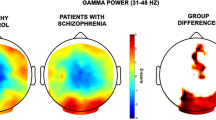Summary
Twenty-three patients with multiple sclerosis were studied during an acute episode and again 4 weeks later. Whereas the patients' clinical condition improved significantly (Kurtzke DSS: from 3.9 (SD 1.4) to 3.3 (SD 1.5),P < 0.001), the conventional power spectra of the resting EEG showed no marked changes. Following a 10-min EEG recording under resting conditions the patients performed a visuomotor tracking task, during which a further EEG recording was made. The frequency of the subvigilant non-A epochs of Loomis et al. as calculated for each minute of the resting recording was taken as the basis for evaluating the EEG dynamics of vigilance. A comparison during and after relapse showed differences in the time courses of the numbers of non-A epochs. While the non-A epochs were not time dependent in the acute phase, remission was characterized by a steady increase in non-A epochs across the 10 min of the recording period. This change in the dynamics of vigilance, which approximates a physiological pattern, was accompanied by an improvement in visuomotor tracking performance. Comparison of the power spectra of the EEG recorded during the tracking task showed a bifrontal increase in absolute alpha power during remission.
Similar content being viewed by others
References
Bente D (1977) Psychophysiologische Aspekte. Verh Dtsch Ges Inn Med 83:945–952
Bräu H, Baum K, Schörner W (1986) EEG-Veränderungen bei Encephalomyelitis disseminata im Vergleich mit den Befunden der zerebralen magnetischen Resonanz-Tomographie. Z EEG-EMG 17:20–26
Bräu H, Ulrich G, Kriebitzsch R, Baum K (1989) Quantifizierung von Funktionsdefiziten bei Multipler Sklerose mittels eines rechnergestützten visuomotorischen Tracking-Verfahrens. Z EEG-EMG 20:84–87
Colon E, Hommes OR, Weerd JPC de (1981) Relation between EEG and disability scores in multiple sclerosis. Clin Neurol Neurosurg 83:163–168
Gibbs FA, Becka D (1968) Reappraisal of the electroencephalogram in multiple sclerosis. Dis Nerv Syst 29:589–592
Harrer G, Harrer H, Kofler B, Haas R (1985) Multiple Sklerose und Elektroenzephalogramm. Computer-EEG-Untersuchungen. Wien Med Wochenschr 135:38–40
Head H (1923) The conception of nervous and mental energy. II. Vigilance: a physiological state of the nervous system. Br J Psychol 14:125–147
Kriebitzsch R, Bente D, Scheuler W (1978) Ein verhaltensphysiologischer Meßplatz zur Untersuchung des optomotorischen Folge- und Regelverhaltens. Biomed Tech (Berlin) 23:147–148
Kurtzke JF (1965) Further notes on disability evaluation in multiple sclerosis with scale modifications. Neurology 15:654–661
Lehmann HJ, Gloeckner RJ (1972) Cerebral disconnexion in multiple sclerosis. Eur Neurol 8:257–269
Lehman HJ, Hauss K, Jainz M (1972) Störungen der Reaktion auf optische Signale bei Multipler Sklerose. Arch Psychiatr Nervenkr 216:371–378
Litvan I, Grafman J, Vendrell P, Martinez JM (1988) Slowed information processing in multiple sclerosis. Arch Neurol 45:281–285
Loomis AL, Harvey EN, Hobart GH (1937) Cerebral states during sleep as studied by human brain potentials. J Exp Psychol 21:127–144
Ponsen L, Jonkman EJ, Weerd AW de, Huffelen AC van (1984) Quantifizierungsmethoden des EEG zur Verbesserung der Diagnosestellung bei Multipler Sklerose. Z EEG-EMG 16:142–144
Poser CM, Paty DW, Scheinberg L, McDonald WI, Davis FA, Ebers GC, Johnson KP, Sibley WA, Silberberg DH, Tourtellotte WW (1983) New diagnostic criteria for multiple sclerosis: guidelines for research protocols. Ann Neurol 13:227–231
Rieger H, Kugler J, Angstwurm H (1970) Abnorme EEG-Befunde bei Multipler Sklerose. Z EEG-EMG 1:141–149
Ulrich G, Frick K (1986) A new quantitative approach to the assessment of stages of vigilance as defined by spatio-temporal EEG patterning. Percept Mot Skills 62:567–576
Ulrich G, Kriebitzsch R (1987) Ein rechnergestütztes visuomotorisches Tracking-Verfahren zur trennscharfen Objektivierung zentralnervöser Pharmakoneffekte. Arzneim Forsch/Drug Res 37:472–475
Ulrich G, Frick K, Stieglitz RD, Müller-Oerlinghausen B (1987) Interindividual variability of lithium-induced EEG-changes in healthy volunteers. Psychiatry Res 20:117–127
Author information
Authors and Affiliations
Rights and permissions
About this article
Cite this article
Bräu, H., Ulrich, G. Electroencephalographic vigilance dynamics in multiple sclerosis during an acute episode and after remission. Eur Arch Psychiatr Neurol Sci 239, 320–324 (1990). https://doi.org/10.1007/BF01735058
Received:
Issue Date:
DOI: https://doi.org/10.1007/BF01735058




